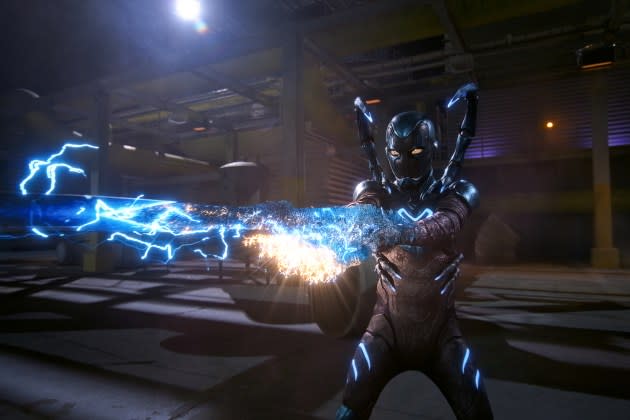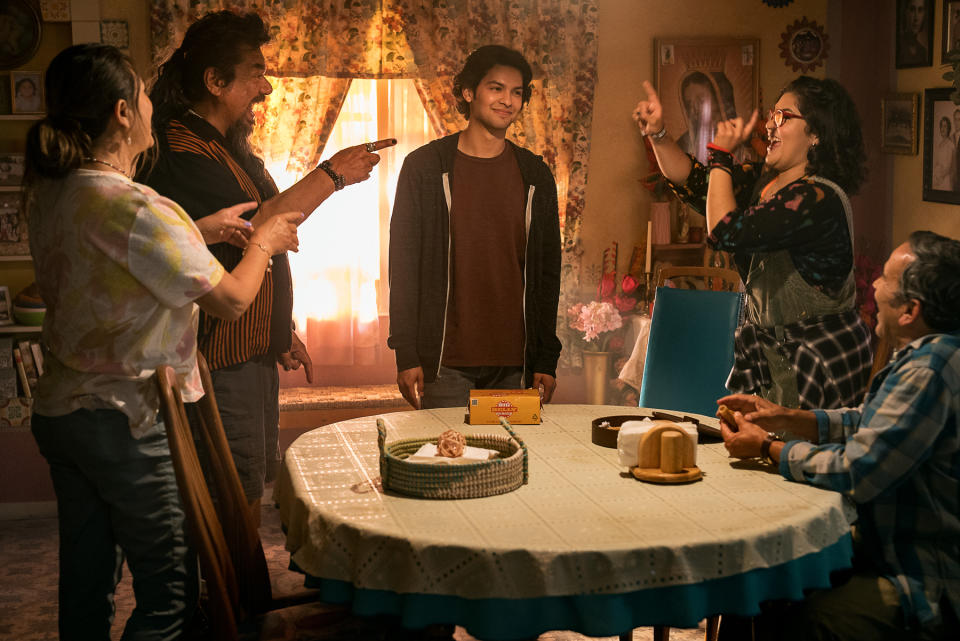‘Blue Beetle’ Is the Same Old DCEU Superhero Movie — With One Big Difference

There’s a lot that’s familiar in Blue Beetle, the latest from — and one of the last remnants of — a dying cinematic universe. It’s a superhero origin story movie, so you’ve got a good sense of what you’re getting right from the get-go: someone ordinary getting thrown into something extraordinary, CGI battles, some wisecracks and rib nudges and heartstring thrums (no Snyderverse dude-brooding here), lots of destruction of public property, more CGI battles. There are rich geniuses with bleeding-edge tech and functioning moral compasses, and other rich folks dying to get their hands on the former at the expense of the latter. There’s an army of lackeys to dispatch before the big boss fight. And at the center of it all is a good-hearted kid, who’s “bitten” by an alien creature that resembles a beetle (not a radioactive spider, but still), then is gifted with an extraterrestrial exoskeleton suit (not made of iron, but still) complete with weaponry, computerized stat readouts, and the ability to fly. The déjà vu is strong in this one.
It’s also a movie that comes with a deep funny-book pedigree, considering the history of the handle. The Blue Beetle’s first appearance was in 1939, roughly a year after Action Comics debuted Superman and a few months after Detective Comics gave us Batman. Three different companies — Fox Comics, Charlton Comics, and DC — have published stories featuring the character fighting for truth, justice, and the insect-costumed-vigilante way; DC bought the rights to the superhero’s name and eventually refashioned him in 2006 as the alter-ego of a Mexican-American teenager named Jaime Reyes. This is the Blue Beetle we get in this late-breaking DCEU entry. And it is the key difference that separates this otherwise generic take on the form we’ve come to know, love, and become seriously fatigued by.
More from Rolling Stone
Marvel VFX Workers Fight to Change Company's 'Live at Work' Culture
The Scarab Finds a New Host in Trailer for DC Comics Flick 'Blue Beetle'
Because what director Angel Manuel Soto (Charm City Kings) and screenwriter Gareth Dunnet-Alcocer (Miss Bala) are bringing to the screen via Reyes’ rise into the good-guy ranks isn’t just a genre, but a culture. First, however, opening credits whip us through beaucoup back story: There was a guy in a blue suit righting wrongs, a corporation known as Kord Industries went through an inter-family power struggle, Ted Kord was named CEO over his sister Victoria (Susan Sarandon), he switched the company from weapons manufacturing to clean energy, then Ted mysteriously disappeared. There’s also a scarab-like object that, once upon a time, rocketed through the galaxy and fell to Earth. Victoria, described as “sexy, in a Cruella-Kardashian kinda way,” had been searching for it for 15 years. Now that she’s finally found it, some serious world-changing shit’s about to go down.
Meanwhile, back in Palmera City — a fictional metropolis located in Texas in the comics, yet is Miami in all but name here — Reyes (Xolo Maridueña) has returned home after graduating college. His family greets him at the airport, then drops some bad news: Their auto-shop business has closed, real estate prices are forcing them out of their house, and Dad (Narcos’ Damián Alcázar) has been having heart trouble. Grad school can wait. Jaime’s sister, Milagro (Belissa Escobedo), gets him a job at a fancy hotel, which is where he meets Jenny Kord (Bruna Marquezine). She’s Ted’s daughter, Victoria’s niece, and majorly pissed over her aunt restarting an aborted project to make supersuits for soldiers powered, somehow, by this mystical alien doohickey.
Long story short, Jenny steals the scarab and passes it to Jaime for safekeeping. While the extended Reyes clan wonders why, exactly, she’d give him “the world’s biggest tick,” it attaches itself to Jaime and outfits him in a head-to-blue suit. Some sort of cosmic computer system (voiced by singer Becky G) is mostly calling the shots, which means our man is less Justice League material and more of an A.I.-controlled meat puppet. He eventually learns to master these newfound superpowers, discovers a connection to the still-M.I.A. Blue Beetle 1.0, and protect his loved ones from Victoria and her Frankenstein’s monster of a henchman (Raoul Max Trujillo), who’s fused into one of her supersuit prototypes. With great power comes great etc., etc.

What comes next is the usual bangzappow!, done in a way that isn’t particularly distinguishable from a million other comic-panel-to-screen blockbusters. This is Stock Superhero Cinema 101, done in a manner that’s functional but almost instantly forgettable. Or it would be, if the entire multiplex-friendly template wasn’t a sort of secret conduit to something extra. Blue Beetle knows what it needs to do, i.e. sell a third-tier superhero that partially ties in to an extended universe of endless callbacks and cross-promotion. (Still, sweet Gotham Law sweatshirt, bro!) What Soto and Dunnet-Alcocer seem more interested in showing you, however, is what’s happening in, around, and right on the periphery of the story. They’ve infused a strong sense of Latino and Latin American culture throughout, as well as a potent strain of social commentary.
In other words, it’s not just that Jaime Reyes is the first Mexican-American superhero with his own solo film — which is indeed a victory unto itself. It’s the fact that this new addition to an extended universe exists in an environment totally informed by, and reflecting back an experience that doesn’t usually get this sort of cinematic real estate. These are Latino neighborhoods, several generations deep, in what appears to be a metropolis with a large Latino population and brimming with Latino influences. The Reyes themselves may be a family that appears to have stepped out of a sitcom already in progress. But they’re also a tight family unit, one that radiates a sense of cultural specificity without dipping into outright caricature. Even George Lopez’s resident black sheep/conspiracy-spouting comic relief Uncle Rudy flashes recognizable humanity beneath all the shouting, crazy facial hair, and mugging for the camera. That’s not an insult, by the way: We congratulate Lopez on consistently stealing the movie outright, and still being charitable enough to keep giving it back. (And his offhand response to someone calling the Beetle an off-brand caped crusader — “Batman is a fascist!” — is almost enough to give Uncle Rudy his own spinoff.)
And Blue Beetle isn’t afraid to call out enemies of that culture that don’t exactly come from comic books. The real supervillain here isn’t a power-mad industrialist or a mech-suited killer, but gentrification — there are a conspicuous amount of “For Sale” signs on houses and foreclosed storefronts on display. You don’t hear someone taunting a rival with “Shouldn’t you be pillaging cobalt from some third-world country?” every day. Racism rears its head in both casual (a receptionist keeps mispronouncing Jaime’s name as “Jay-mee”) and not-so-casual ways (Victoria continually refers to a scientist, played by What We Do in the Shadows’ Harvey Guillén, as “Sanchez”… which, as you may have guessed, is not his name). When was the last time you saw a superhero film that indirectly hinted at a character’s Zapatista past and then made it pay off? Or directly namechecks the School of the Americas, our nation’s involvement in South American conflicts, and Guatemalan child soldiers?
Blue Beetle does all of this, often with a righteous sense of fury that’s noticeable beneath the same ol’ sturm und drang of a typical loud, clumsy, fumbling blockbuster. It doesn’t transform the film into the second coming of Black Panther, still the gold standard, but it does make it feel a lot more personal and remarkable while it’s padding a corporate bottom line. Especially since, in terms of the pre-reboot DC cinematic universe, this is essentially a white dwarf. (Confusingly, newly appointed D.C. Grand Poobah James Gunn says that while his upcoming Superman film is “the first full DCU movie”, Reyes is the first character in his DCU. It’s complicated.) A post-credits sequence hints at another chapter, which the movie likely won’t get. The pity is that we probably don’t need another Blue Beetle adventure. What Soto and company have done with the saga of Jaime Reyes, however, suggests a formula that may save this whole genre from simply going down, down, and away.
Best of Rolling Stone

